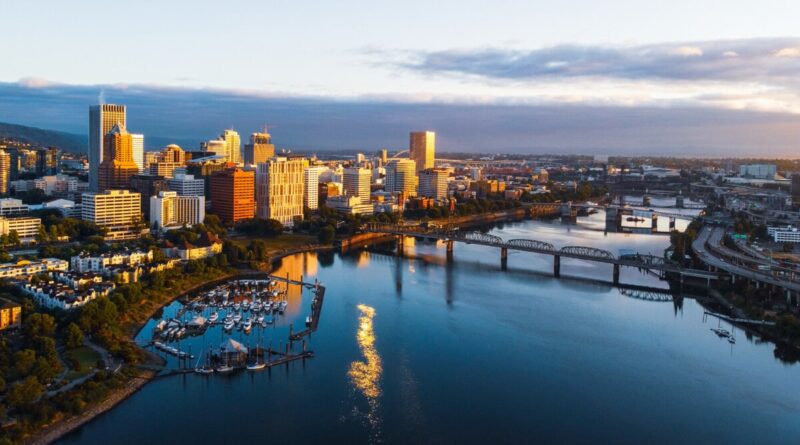History of Portland Oregon
Portland, Oregon, known as the “City of Roses,” has a rich and varied history. The area that is now Portland was originally inhabited by indigenous peoples for thousands of years before European settlers arrived. The Multnomah, Clackamas, and other Chinookan tribes thrived in the region, benefiting from the abundant natural resources provided by the Columbia and Willamette rivers.
The first recorded European contact in the area was by British explorer William Robert Broughton in 1792, a member of George Vancouver’s expedition. However, it was not until the early 19th century that European settlers began to establish a permanent presence. The Lewis and Clark Expedition, which passed through the area in 1805-1806, highlighted the region’s potential for settlement and trade.
In 1829, a retired Hudson’s Bay Company employee, French-Canadian fur trapper Étienne Lucier, settled in the area and began farming on the east bank of the Willamette River. This marked the beginning of the settlement that would eventually become Portland.
The Naming of Portland
The city of Portland was officially founded in 1845. Its name was decided by a coin toss between two of its early settlers, Asa Lovejoy of Boston, Massachusetts, and Francis Pettygrove of Portland, Maine. Pettygrove won the toss, and the fledgling town was named after his hometown of Portland, Maine. If the coin toss had gone the other way, the city might have been named Boston, Oregon.
Growth and Development
Portland’s growth was spurred by its advantageous location along the Willamette River, making it a natural transportation and trade hub. The California Gold Rush of 1849 further fueled its growth, as Portland became a primary supply center for prospectors heading to the gold fields. By 1850, Portland had grown into a bustling port town with a population of around 800.
The arrival of the Oregon Trail also significantly contributed to Portland’s development. Thousands of settlers traveled westward, many of whom settled in the Willamette Valley. Portland’s strategic location made it a critical point for distributing goods and services to the surrounding areas.
The Late 19th Century
The late 19th century saw Portland’s transformation from a rough frontier town into a major urban center. The establishment of the Oregon Steam Navigation Company in 1860 facilitated more efficient transportation of goods along the Columbia River, further enhancing Portland’s status as a key trading hub. In 1883, the arrival of the Northern Pacific Railway connected Portland to the transcontinental railroad network, marking a significant milestone in the city’s growth.
Portland also became known for its timber industry. The vast forests of the Pacific Northwest provided a seemingly endless supply of timber, which was processed and shipped from Portland to markets around the world. By the turn of the 20th century, Portland was one of the largest cities in the Pacific Northwest, with a population of over 90,000.
The Early 20th Century
The early 20th century brought both challenges and opportunities for Portland. The city’s economy continued to grow, driven by its strategic location and diversified industrial base. However, the 1905 Lewis and Clark Centennial Exposition played a pivotal role in putting Portland on the national stage, attracting over 1.6 million visitors and promoting the city as a thriving and modern urban center.
During this period, Portland also developed a reputation for its vibrant cultural scene. The city became known for its music, theater, and arts communities, which laid the groundwork for its later reputation as a cultural and artistic hub.
Mid-20th Century Changes
The mid-20th century saw significant changes in Portland’s economy and demographics. The decline of the timber industry and shifts in the manufacturing sector prompted the city to diversify its economic base. The rise of the high-tech industry in the 1980s and 1990s, particularly with the establishment of companies like Intel in the nearby Silicon Forest, marked a new era of economic growth and innovation.
Portland also became known for its progressive urban planning policies. In the 1970s, the city adopted a pioneering urban growth boundary to control suburban sprawl and preserve the surrounding natural landscape. This focus on sustainable development and environmental conservation became a defining characteristic of Portland’s identity.
Modern Portland
Today, Portland is renowned for its quality of life, environmental consciousness, and vibrant cultural scene. The city’s commitment to sustainability is evident in its extensive public transportation system, bike-friendly infrastructure, and green spaces. Portland’s food and beverage scene, including its famous food carts and craft breweries, has garnered national acclaim.
The city’s diverse neighborhoods, each with its unique character and charm, reflect Portland’s rich history and dynamic evolution. From the historic homes in the Alphabet District to the trendy shops and restaurants in the Pearl District, Portland seamlessly blends its past and present.
Conclusion
The history of Portland, Oregon, is a testament to its resilience, adaptability, and innovative spirit. From its early days as a frontier settlement to its current status as a thriving urban center, Portland has continuously evolved while maintaining its unique character and charm. As the city continues to grow and change, its rich history remains an integral part of its identity, shaping its future and inspiring its residents and visitors alike.
Discover more from City Towner
Subscribe to get the latest posts sent to your email.




